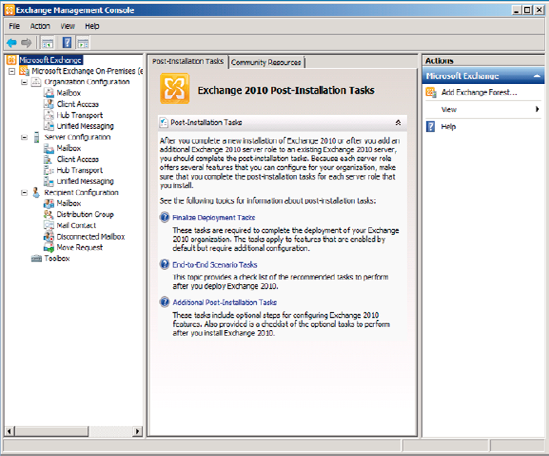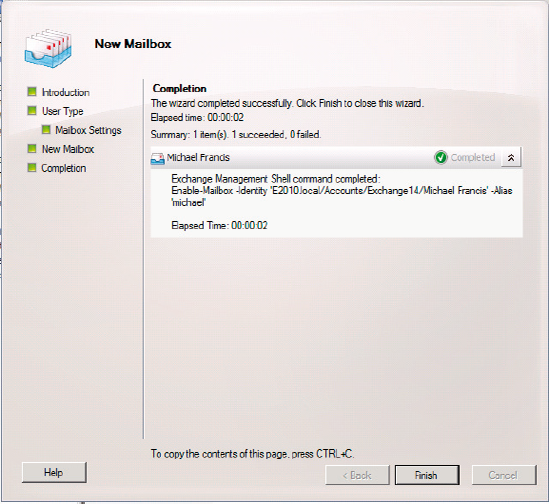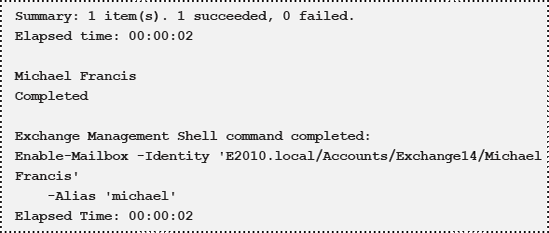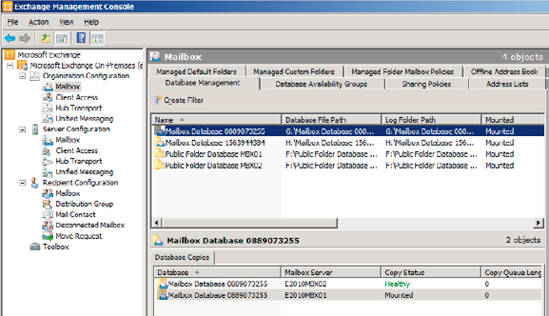The
Exchange Management Console is the Graphical User Interface for managing
the Exchange Server 2010 environment. The Exchange Management Console
is an MMC 3.0 snap-in and consists of several panes (see Figure 1 below).
Navigation Pane
– this is the left-hand pane where the Exchange Organization is
visible, and it features different leaves like the Organization
Configuration, the Server Configuration, the Recipient Configuration and
the Toolbox.
Results Pane – this is the middle pane where the results about the selection in the Navigation Pane are visible.
Actions Pane
– this is the right-hand pane, where actions that need to be performed
against the selections made in the other two panes are chosen.
When the Organization Configuration in the Navigation
Pane is selected, the organization-wide configuration of the Exchange
Organization can be managed, which all the Exchange servers in the
entire organization will share. In the organizational configuration,
information can be set for example about Send Connectors, Accepted
Domains, Email Address Policies, Database Availability Group, Mailboxes,
etc. The Server Configuration in the Navigation pane contains all the
server-specific configuration options, such as a particular server's
Receive Connectors, Outlook Web App settings or Outlook Anywhere
settings.

Lastly, the Recipient Configuration contains all configuration options regarding the following recipients:
Mailbox
Distribution Group
Mail Contact
Disconnected Mailbox
Move Request
1 PowerShell and the EMC
The easiest way to learn the PowerShell commands
you'll need to manage Exchange Server 2010 is to remember that, as the
Exchange Management Console is written on top of the Exchange Management
Shell, every action in the Management Console is translated to a
Management Shell command. This is important because it's possible to
take an action in the EMC, and then see its PowerShell equivalent.
For example, to mail-enable a user in the Management Console:
In the Navigation Pane, select the Recipients configuration and select Mailbox. In the Actions pane select New Mailbox.
In the New Mailbox Wizard select "User Mailbox," and then click Next.
In
the User Type Windows, select "Existing user" and click the Add button.
Select an available user object (this user object must be already
created) and click OK. Click Next to continue.
In the Mailbox Settings Windows, enter an appropriate alias for the new mailbox. Click Next to continue.
In the New Mailbox window verify the configuration that's entered and click New to create the new mailbox.
All of the configuration information that you've just
entered is being translated to a Management Shell command on the fly,
and this command is executed then. When the command is executed the
window shown in Figure 2 appears.

In the lower part you see "To copy the contents of
this page, press CTRL+C." If you press CTRL+C the contents of this
dialog is copied to the Windows clipboard, which contains the following:

This is the actual command that was executed, and this is by far the easiest way to learn the PowerShell commands.
2 Evolution of the Exchange Management Console
If you're familiar with Exchange Server 2007, the Exchange Management Console should be familiar as well. There are
some changes though, primarily because of architectural changes in
Exchange Server 2010. Mailbox Databases, for example, are not on the
server level as in Exchange Server 2007, but on the organization level.
For managing the Mailbox Database, the Organization Configuration now needs to be selected instead of the Server Configuration (as is the case in Exchange Server 2007).
Since Mailbox Databases are on the organization
level, individual Mailbox Database names must be unique across the
entire organization. This is the reason why default Mailbox Databases
are created with names like "Mailbox Database 0889073255" and "Mailbox
Database 1563944384."
A new feature in the Exchange Management Console is
the option to manage multiple Exchange organizations in a single Console
(see Figure 4).
If you open the Exchange Management Console, by default the Exchange
On-Premises organization of which the Exchange Server is a member is
shown.

In the Actions Pane, click "Add Exchange forest" and
enter the Fully Qualified Domain Name (FQDN) of another Exchange
organization you have access to. Enter the proper credentials and two
separate Exchange organizations can be managed at once from a single
console. The ability to manage multiple locations and multiple
organizations is one of the things that Exchange Server 2010 now does
very well.
